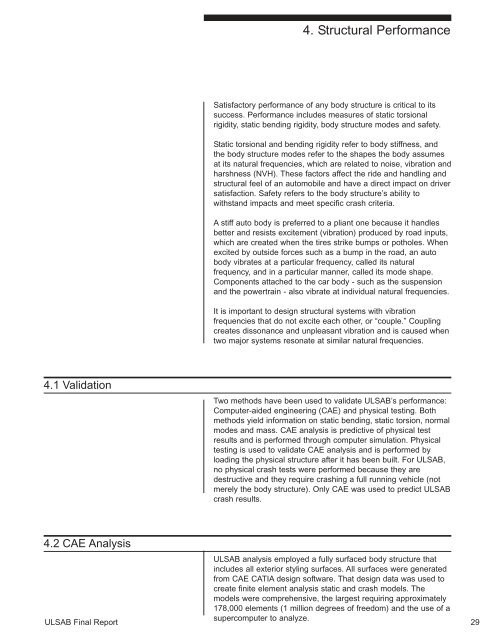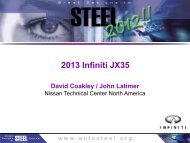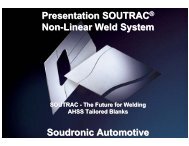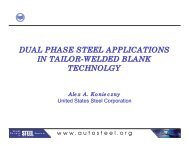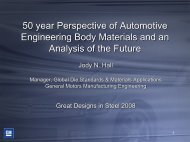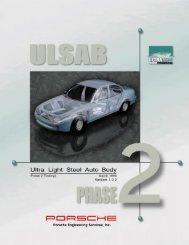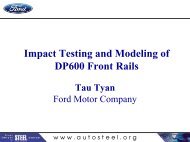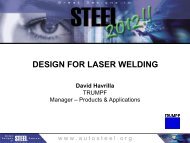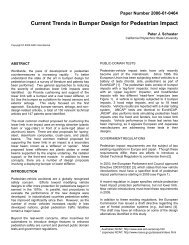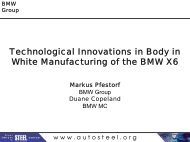UltraLight Steel Auto Body - Final Report - American Iron & Steel ...
UltraLight Steel Auto Body - Final Report - American Iron & Steel ...
UltraLight Steel Auto Body - Final Report - American Iron & Steel ...
Create successful ePaper yourself
Turn your PDF publications into a flip-book with our unique Google optimized e-Paper software.
4.1 Validation<br />
4.2 CAE Analysis<br />
4. Structural Performance<br />
Satisfactory performance of any body structure is critical to its<br />
success. Performance includes measures of static torsional<br />
rigidity, static bending rigidity, body structure modes and safety.<br />
Static torsional and bending rigidity refer to body stiffness, and<br />
the body structure modes refer to the shapes the body assumes<br />
at its natural frequencies, which are related to noise, vibration and<br />
harshness (NVH). These factors affect the ride and handling and<br />
structural feel of an automobile and have a direct impact on driver<br />
satisfaction. Safety refers to the body structure’s ability to<br />
withstand impacts and meet specific crash criteria.<br />
A stiff auto body is preferred to a pliant one because it handles<br />
better and resists excitement (vibration) produced by road inputs,<br />
which are created when the tires strike bumps or potholes. When<br />
excited by outside forces such as a bump in the road, an auto<br />
body vibrates at a particular frequency, called its natural<br />
frequency, and in a particular manner, called its mode shape.<br />
Components attached to the car body - such as the suspension<br />
and the powertrain - also vibrate at individual natural frequencies.<br />
It is important to design structural systems with vibration<br />
frequencies that do not excite each other, or “couple.” Coupling<br />
creates dissonance and unpleasant vibration and is caused when<br />
two major systems resonate at similar natural frequencies.<br />
Two methods have been used to validate ULSAB’s performance:<br />
Computer-aided engineering (CAE) and physical testing. Both<br />
methods yield information on static bending, static torsion, normal<br />
modes and mass. CAE analysis is predictive of physical test<br />
results and is performed through computer simulation. Physical<br />
testing is used to validate CAE analysis and is performed by<br />
loading the physical structure after it has been built. For ULSAB,<br />
no physical crash tests were performed because they are<br />
destructive and they require crashing a full running vehicle (not<br />
merely the body structure). Only CAE was used to predict ULSAB<br />
crash results.<br />
ULSAB <strong>Final</strong> <strong>Report</strong><br />
ULSAB analysis employed a fully surfaced body structure that<br />
includes all exterior styling surfaces. All surfaces were generated<br />
from CAE CATIA design software. That design data was used to<br />
create finite element analysis static and crash models. The<br />
models were comprehensive, the largest requiring approximately<br />
178,000 elements (1 million degrees of freedom) and the use of a<br />
supercomputer to analyze.<br />
29


